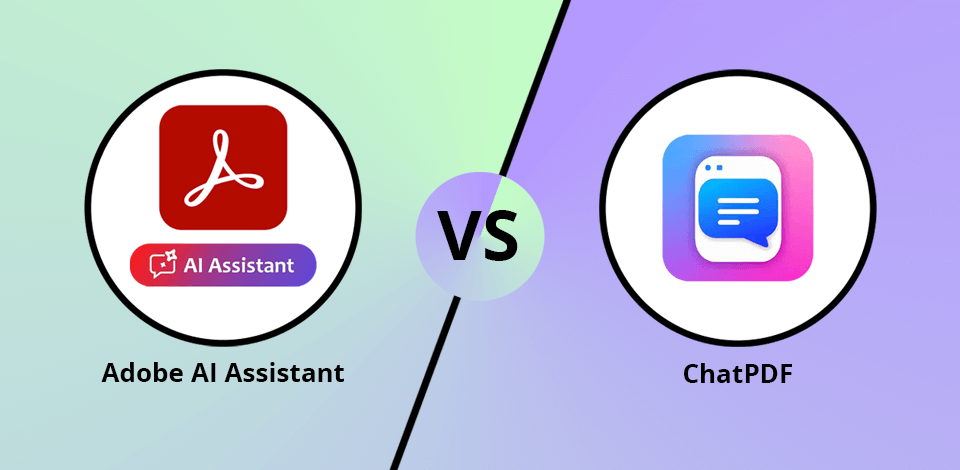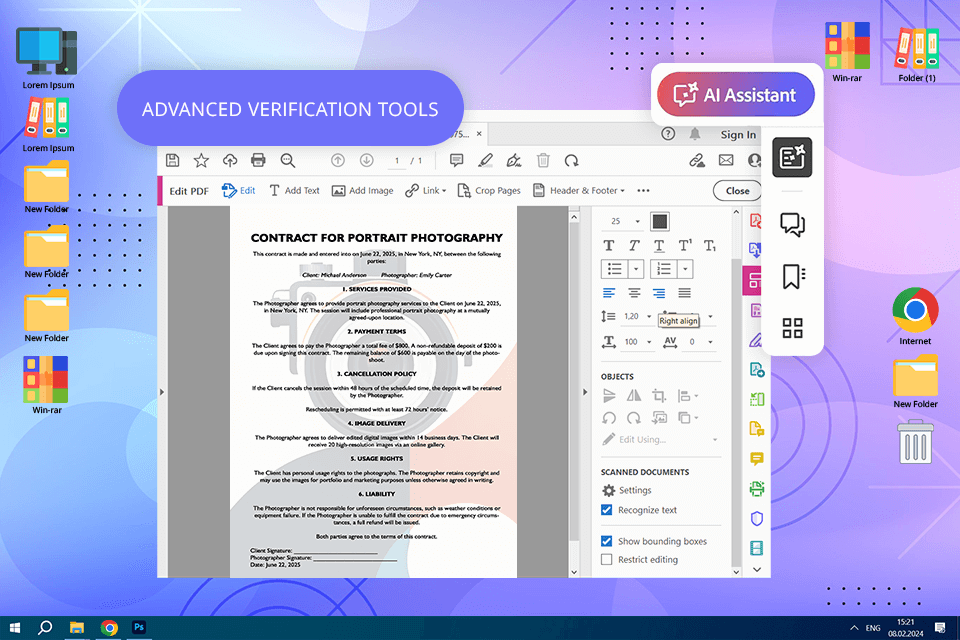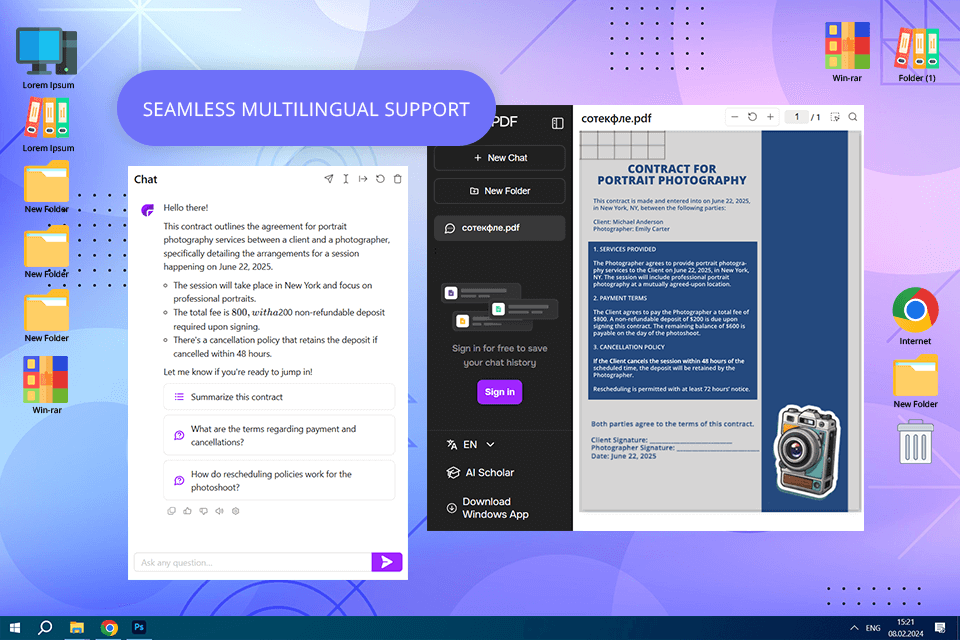
Both Adobe AI Assistant in Acrobat and ChatPDF are designed to make working with PDFs more efficient. As a FixThePhoto editor, I frequently deal with camera manuals, editing guides, and client contracts. Searching for specific details manually is a time-consuming job, especially when summarizing editing tips or pulling key details from long documents.
To accelerate my workflow, I decided to delegate some part of my job to one of so hyped AI tools for PDF. It helped me discover the needed info about camera settings, summarizing advanced retouching methods, or extracting important terms from contracts.
While looking for the best tool, I tried two leading AI-powered PDF assistants: the recently updated Adobe AI Assistant, which now includes a Contract feature and ChatPDF. I evaluated them on accuracy, speed, ease of use, and how helpful they were for photography-related documents.
| Adobe AI Assistant | ChatPDF | |
|---|---|---|
|
|

|

|
|
Pricing
|
Free trial Monthly: $6.99 Annual: $4.99/month Annual: $59.88/year |
Free version Pro Plan: $10/month Plus Plan: $19.99/month Enterprise: custom |
|
Rating
|
(5/5) ★★★★★
|
(4.5/5) ★★★★☆
|
|
Key features
|
Answers from various files One-click summary Citation and source verification File organization Proofreading and translation |
Multi-file chats Summarize PDFs Summary with citations Translate PDFs Side-by-bide view |
|
Pros & Cons
|
✔️ Extensive toolkit |
✔️ Real-time collaboration |
|
Best for
|
Professional using
|
Quick tasks
|
One of my main jobs is finding key details in long documents, so I tried out both tools by creating summaries of a 50-page camera manual and a client contract. With Adobe AI Assistant in Acrobat, I uploaded the PDFs and used the summary tool. The results really impressed me, as the AI quickly identified key details such as camera settings, shooting modes, and troubleshooting tips – and all these in clear and straightforward language. For the contract, it highlighted critical sections, deadlines, and responsibilities, significantly speeding up the review process.
In contrast, ChatPDF, made me ask for a summary manually in its chat. It provided excellent overviews, but they weren’t as organized as Acrobat’s one-click summaries. When I summarized my PDF file, ChatPDF skipped some details about advanced settings, and for the contract, it didn’t clearly highlight the key differences between sections, unlike Acrobat. In the end, Acrobat AI Assistant offered quicker and more precise summaries, making it the better option for my workflow.
I frequently need quick answers when working with photography-related PDFs, whether it’s about a specific camera setting or clarifying a contract clause. To test this feature, I uploaded my camera manual, questioning both tools “What is the maximum shutter speed of this model?”. The answer provided by Adobe AI Assistant in Acrobat appeared in an instant. It was comprehensive and even included a direct link to the section in the document. In such a way, I could easier verify the details without the hassle of scrolling through the document.
ChatPDF also provided the correct answer but in a more conversational style. Instead of giving me the exact number right away, it first explained the context before mentioning the shutter speed. This allowed me to understand everything better, but when it came to getting quick answers, the speed suffered. However, ChatPDF stood out with follow-up questions, it felt more conversational and interactive, making it ideal for deeper, more detailed discussions. So, if you want to go deeper into the topic, this AI tool to chat with PDF is an ideal option.
When verifying AI-generated answers, accuracy is essential, especially with technical documents. I tested both tools by extracting camera specifications from a product manual. Adobe AI Assistant in Acrobat delivered a precise and correct list of features, including megapixels, shutter speed, and ISO range. However, I needed to verify the information, which was a no-brainer since Acrobat linked each response to a specific section in the document.
While reviewing ChatPDF, I found out that it provided accurate answers but it was a bit more prone to small errors with complex technical details. When I inquired about lens specs, it gave me the correct answer, but I had to ask a follow-up question to clarify the exact lens type, as the first response wasn’t entirely clear. ChatPDF AI was mostly reliable, but Acrobat’s clear answers and linked sources made it more trustworthy. This meant less need for double-checking.
Both tools are user-friendly but work in different ways. Adobe AI Assistant integrates seamlessly with the Acrobat system. If you're familiar with Adobe products, you won’t have trouble using it. The interface is simple: just upload a document, ask a question, or generate a summary with one click. Navigation feels smooth and chatting with multiple PDFs at once is a standout feature. However, the free trial allows only 100 questions. After that, you’ll need a paid plan.
This is where ChatPDF stands out. While its interface isn’t as sleek as Acrobat’s, it’s simple and will be clear even for novices with no experience with the platform. More importantly, it has a free version. Although restricted to 2 PDFs per day, it allows you to test the tool without quickly reaching a usage limit. If you only need AI help now and then, ChatPDF is a more budget-friendly choice.
Contract analysis capabilities are what appealed to me about Adobe AI Assistant. After uploading two versions of a client contract, the tool defined the differences between them in an instant. For anyone reviewing multiple versions of legal documents, this saves a lot of time. Another impressive feature is table analysis. Acrobat can turn complicated tables into clear, easy-to-read insights, which was incredibly useful when working with camera spec sheets full of technical details.
ChatPDF, however, shines with its multilingual support. Unlike Acrobat, which only recently added a few European languages, it works with almost any language right away. When I tested it with a Japanese camera manual, it easily summarized the key sections in English without any trouble. Its source citation feature is another selling point of the program. When answering a question, ChatPDF clearly mentions which PDF and page the information comes from, making it easier to verify facts.
Comparing Adobe AI Assistant Acrobat vs ChatPDF, I came to the following conclusion. The Adobe product appeals to users with highly accurate summarization, reliable question-answering with source linking, and top-notch verification tools. Unlike ChatPDF, this artificial intelligence software seamlessly integrates with other Adobe products, making it an ideal option for specialists who heavily work with PDF files.
ChatPDF offers a free version, but Acrobat stands out with a more refined and robust experience, particularly for professionals seeking AI-driven insights. Its contract comparison and table analysis tools extend functionality, making it ideal for technical documents.
Beyond basic AI support, the Adobe AI Assistant can make you more productive. It offers advanced features like summarizing lengthy presentations, crafting marketing plan summaries, and enabling quick document searches. Now, with the ability to handle documents up to 200 pages, the program has become a better solution for processing larger files. Additionally, its table analysis tools allow you to easily extract key insights from complex data for professional purposes.
Those who know how to use Adobe Acrobat AI Assistant and ChatPDF can make their PDF workflow faster and more efficient. They can summarize, extract essential details, and analyze tables, but they aren’t perfect. One major issue is accuracy and understanding of context. AI has trouble with poorly formatted documents, scanned PDFs, or complex layouts like financial reports with detailed tables or legal contracts with footnotes. If the AI misreads a section, the output can be inaccurate, so double-checking is always necessary.
Moreover, AI technology cannot guarantee absolute privacy and security, which is a serious stumbling block. It often deals with sensitive documents, such as contracts, business reports, and confidential agreements, making users concerned about how this data is stored and used. While Adobe Acrobat guarantees top-level security, some third-party AI tools might not have strong encryption or meet compliance standards, posing risks for professionals dealing with confidential data.
Finally, AI’s ability to grasp complex questions is still improving. While both Acrobat AI Assistant and ChatPDF can answer questions based on PDFs, their accuracy depends on the way the document is organized. AI might miss important context, misunderstand unclear phrases, or fail to link related details across pages. So, though AI algorithms are so sophisticated, human review is still essential. This is especially true for tasks requiring high precision, like contract analysis or technical document reviews.
Together with the FixThePhoto team, we tried our best to compare Adobe AI Assistant in Acrobat and ChatPDF in a practical and objective way.
We tested and rated both tools in real-world situations. Our team uploaded a variety of PDFs, including camera manuals, photography editing guides, client contracts, and complex marketing presentations, as we usually work with them regularly. Our goal was to evaluate how effectively each AI assistant could summarize key details, answer technical questions, and assist in analyzing complex content.
Summarization speed and accuracy were one of the main criteria we considered. I chose lengthy documents, like a 100-page retouching guide and an in-depth stock image licensing contract. Adobe AI Assistant excelled at extracting key details and delivering structured summaries. On the other hand, ChatPDF provided clear answers but occasionally missed important context, especially with larger files.
Next, we tested how well both AI tools answered questions. I asked specific and detailed queries, such as “What are the best camera settings for low-light street photography?” and “What are the main differences between these two client contracts?” Adobe AI Assistant performed better, especially with technical and contract-related questions. It was great at comparing multiple documents and giving thorough answers. ChatPDF, while useful, sometimes had trouble with longer, multi-part questions and didn’t always handle more complex cases as well.
To evaluate user experience and accessibility, our team split into two groups: one tested the desktop version of Acrobat, while the other examined its mobile app, focusing on voice chat functionality to assess its performance on the go.
Additionally, we experimented with ChatPDF’s free version to gauge its features without a paid subscription. Adobe AI Assistant stood out for its smooth integration with the Acrobat ecosystem. On the other hand, ChatPDF is a reliable choice for quick, informal PDF analysis and is especially attractive to users who don’t want to pay for a subscription.